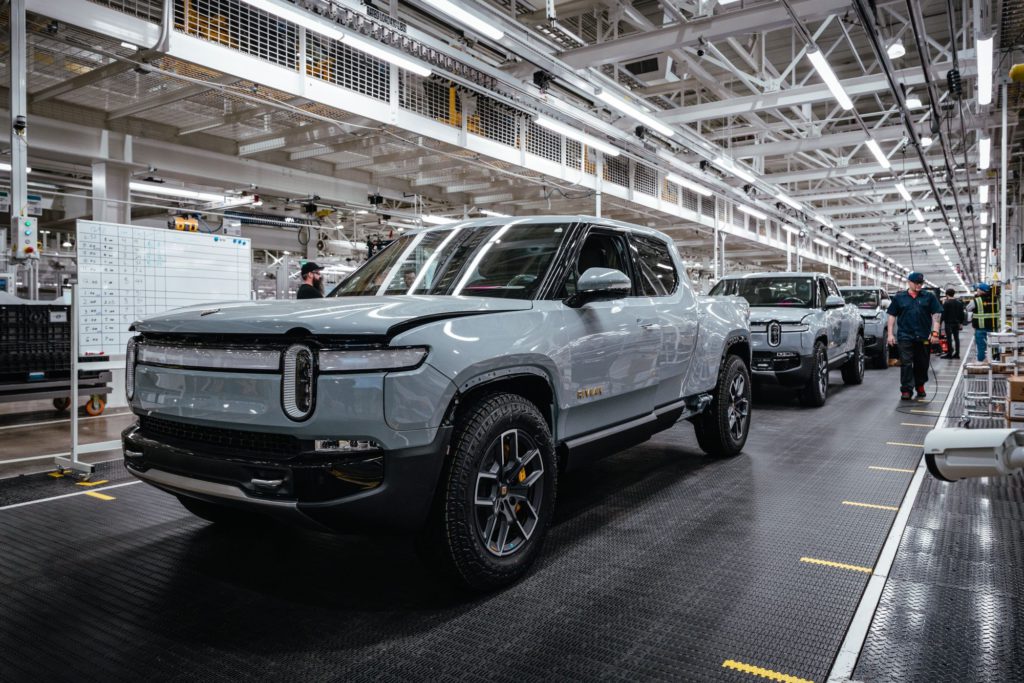(Bloomberg) — Rivian Automotive Inc. reaffirmed guidance to deliver 25,000 battery-electric vehicles this year, despite ongoing supply chain snarls hampering its ramp in production.
The Irvine, California-based carmaker has built about 5,000 vehicles since production started in September, it said Wednesday. That includes 2,553 units built in the first quarter against a backdrop of assembly line pauses due to parts shortages. The company, which manufactures a mix of pickup trucks, SUVs and commercial vans, delivered 1,227 vehicles to customers in the quarter.
Rivian surged as much as 14% in after hours trading, before paring some of the gain. The stock earlier closed down 9.6% to $20.60 and has dropped about 80% so far this year. The shares were rocked this week by a lockup expiry that allowed insiders and big-name investors to sell.
Read more: Ford Sold 8 Million Shares of Rivian at $26.80 Each on Monday
The all-electric startup is struggling after a blockbuster listing in November, the sixth biggest IPO on U.S. record, helped put it on the map. The company was first-to-market with an electric pickup, beating out Ford Motor Co. — one of its investors — and the likes of General Motors Co and Tesla Inc. It has blamed parts shortages, Covid-19 outbreaks and production hiccups for holding it back.
Rivian reported $95 million of first-quarter revenue, less than the average analyst estimate of $131.2 million. The EV-maker recorded an adjusted loss of $1.43 a share, slightly better than the average estimate of $1.45.
“Supply chain continues to be the bottleneck of our production,” Rivian said in its shareholder letter. “We have been forced to stop production for longer periods than anticipated, resulting in approximately a quarter of the planned production time being lost due to supplier constraints.”
Shipping Costs
The company encountered increased shipping and logistics costs as it tried to circumvent parts shortages. While a lack of semiconductors remains a problem, the worst of the shortage has passed, Chief Executive Officer RJ Scaringe said on a call with analysts.
Rivian doesn’t foresee any issues around the supply of battery cells over the next five years, Scaringe said. The company is, however, trying to reach longer-term deals for battery metals supply as global EV output, and competition, grows.
Rivian said it ended the quarter with $17 billion in cash and cash equivalents, excluding additional lines of credit, down from $18.4 billion at the end of 2021. The company said the funds are sufficient to take it through to the start of production of a next-generation mid-price vehicle to be assembled at a new plant to be built in Georgia by 2025.
Amazon Order
Alongside its consumer models, Rivian has an order for 100,000 battery-electric delivery vans from Amazon.com Inc., its second-largest shareholder. The first 10,000 are due by the end of this year and are factored into its full-year guidance.
While output from Rivian’s sole operational plant in Normal, Illinois, is constrained, it’s already trying to expand its manufacturing footprint to boost capacity. The company received $1.5 billion in state and local incentives earlier this month to build a second $5 billion factory near Atlanta.
Cash burn is still a concern for investors. Rivian said it would work through about $7 billion in 2022, split across negative earnings before interest, taxes, depreciation and amortization, and capital expenditures.
In working toward its full-year delivery target, Rivian plans to add a second shift at the Illinois plant as long as its supplier base can support the output. That facility has installed capacity to produce 150,000 units annually.
The company said it has more than 90,000 net pre-orders, stripping out those that have been delivered, for its consumer vehicles. This includes 10,000 new orders placed since the company raised prices in March in a series of U-turns that hurt the stock.
(Updates with details from conference call and outlook on supply chain.)
More stories like this are available on bloomberg.com
©2022 Bloomberg L.P.











